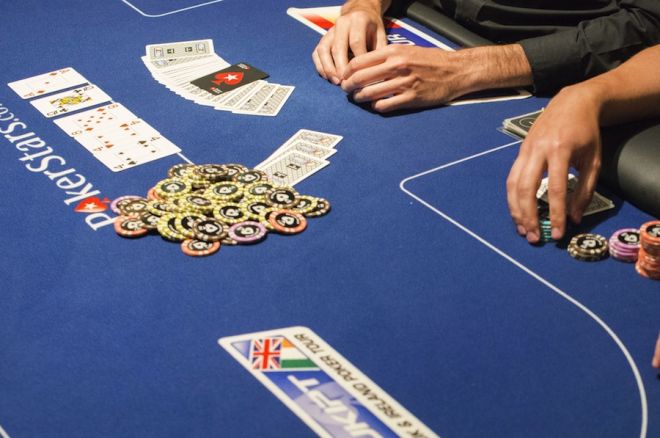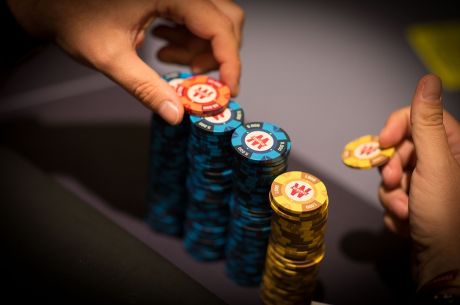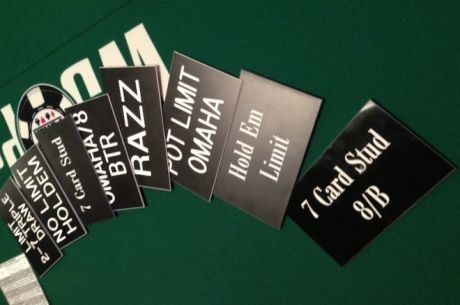Assess Strange Poker Situations Accurately with This One Weird Trick

It's hard to reason accurately about unusual situations, in poker as in life.
One reason for this is that it's much harder to draw on your experience to figure out what's going on. Another obstacle, however, is that usual ways of analyzing hands become far more difficult. Here I'll describe a simple but effective way to modify one such procedure in unusual spots.
Specifically, I'll talk about counting combinations, which is a good way to figure out your opponent's range, but which gets messy as ranges get very wide or very narrow. When almost every explanation for an opponent's play is unlikely, you wind up trying to add up sets of fractions in your head (which isn't easy to do accurately over the felt, at least for me), or else you risk making rounding errors that are large relative to the quantities with which you're dealing.
The underlying problem is that, in these spots, the opponent's likelihood of playing any hand as he did is often small (less than 10%, say). So, if you think he'd play the nut-flush draw a certain way with 5% likelihood and top set that way with 10% likelihood, you wind up weighing .45 (9 combos x .05) against .3 (3 combos x .1). Although this comparison is manageable, it gets much harder quickly, especially if you then need to multiply by your equity against these hands.
My suggestion is simple. First, take the hand for which the probability of your opponent's playing this way is the highest (given that he was dealt it). Then use that to normalize everything else �� that is, set that probability to 1 and judge all the other probabilities relative to that one.
So, in the example above, top set has the highest probability (this won't be true after you make Bayesian adjustments, but it is the hand most consistent with the action, and it therefore has the highest multiplier). Therefore, you would first count the full 3 combinations of top set. You would then count half the combinations of the nut-flush draw, since it is half as likely to be played that way as top set is. You will wind up with 3 combinations versus 4.5 �� this is the same result as before, but scaled up by a factor of 10.
This approximation technique has several benefits:
- It doesn't introduce any error; it simply puts the calculation on a scale that is easier for you to handle over the felt.
- It facilitates equity calculations, as numbers between (roughly) 5 and 50 tend to be easier to multiply by equities between 0 and 1 than smaller numbers are.
- Perhaps most importantly, it facilitates making accurate probability judgments in the first place. Most of us aren't good at keeping an intuitive handle on the difference between 3% and 5% probability, especially when you're trying to process a lot of psychological and strategic information in the meantime. It can be much easier to keep an accurate intuitive grasp of relative probabilities.
Here's a quick example to illustrate putting this technique into practice.
You raise UTG in a 6-max game with K?K? and are called by UTG+1. The flop comes K?3?2?. You check, because you would like to protect some other hands that are vulnerable on this flop and because you have other value hands to bet with (such as AxKx and AxAx). Your opponent checks behind.
The turn comes the 10?, putting up a flush draw. You bet half the pot and get called. The river is the 9?. You bet half the pot and your opponent raises one-and-a-half times the pot.
Now let's not worry about whether the hand was played well or badly, as described �� let's just try to read your opponent's hand by counting combinations against a hypothetical opponent.
He could have a straight.
He could have a smaller set.
He could be bluffing with a missed flush draw.
He could be making a value-raise with two pair.
This suggests four categories of hands, with those categories including QxJx-suited, the bigger sets (10x10x and 9x9x), the smaller sets (3x3x and 2x2x), the better nut-flush draws (A?Q?, A?J?), and the other nut-flush draws (A?8? through A?2?).
Of these, QxJx-suited will be most likely for many small-stakes opponents. Not all opponents will call a raise with this hand. Some will bet the flop or raise the turn with it, and many will make a smaller raise with it on the river. Often, though, this is the hand that is most consistent with the action, so we count all 4 combinations of it.
The bigger sets make a little less sense, in part because they have to worry about KxKx (so they might raise less) and in part because many of them would raise or fold the turn. Let's say those are 2/3 as likely as QxJx-suited �� 6 x 2/3 = 4, so we have 4 combinations of bigger sets.
The smaller sets are a bit less likely still, as many opponents will fold these before the flop or play more aggressively on the flop or turn. Let's say these are 1/3 as likely as QxJx-suited and half as likely as the bigger sets �� 6 x 1/3 = 2, so that's 2 combinations of smaller sets.
Finally, the better flush draws might be roughly 1/5 as likely as QxJx-suited, and the smaller flush draws (some of which had a pair) roughly 1/10 as likely, especially if your opponents aren't eager to make overbet bluffs or if they're tight before the flop �� so... 2 x 1/5 = 0.4 and 7 x 1/10 = 0.7, giving 1.1 combinations of flush draws.
So there are 4 (modified) combinations of hands that beat us, 6 combinations of worse value-betting hands, and 1.1 combinations of bluffs. If the opponent will call a reraise with a set, you should reraise. If that's less than 2/3 likely, you should call. Against this opponent, you definitely shouldn't fold.
The calculation above is not perfect. But I have found that this technique gets me closer to a good answer, with less chance to make a big error, than trying to count combinations without scaling them. I hope it works for you as well as it does for me.
The Kindle edition of Nate Meyvis's new book, Thinking Tournament Poker, Volume 2, is now available on Amazon. Be sure also to check out Nate and Andrew Brokos on the Thinking Poker Podcast, and for more from Nate visit his blog at natemeyvis.com.
Want to stay atop all the latest in the poker world? If so, make sure to get PokerNews updates on your social media outlets. Follow us on Twitter and find us on both Facebook and Google+!









